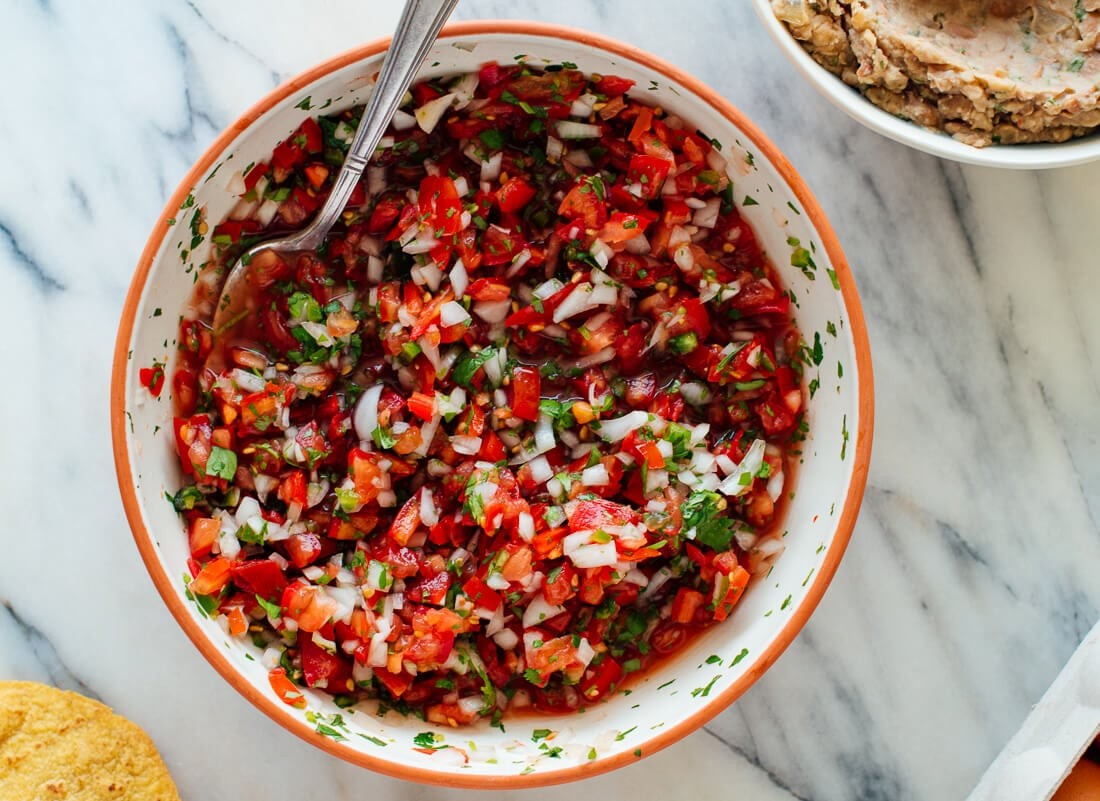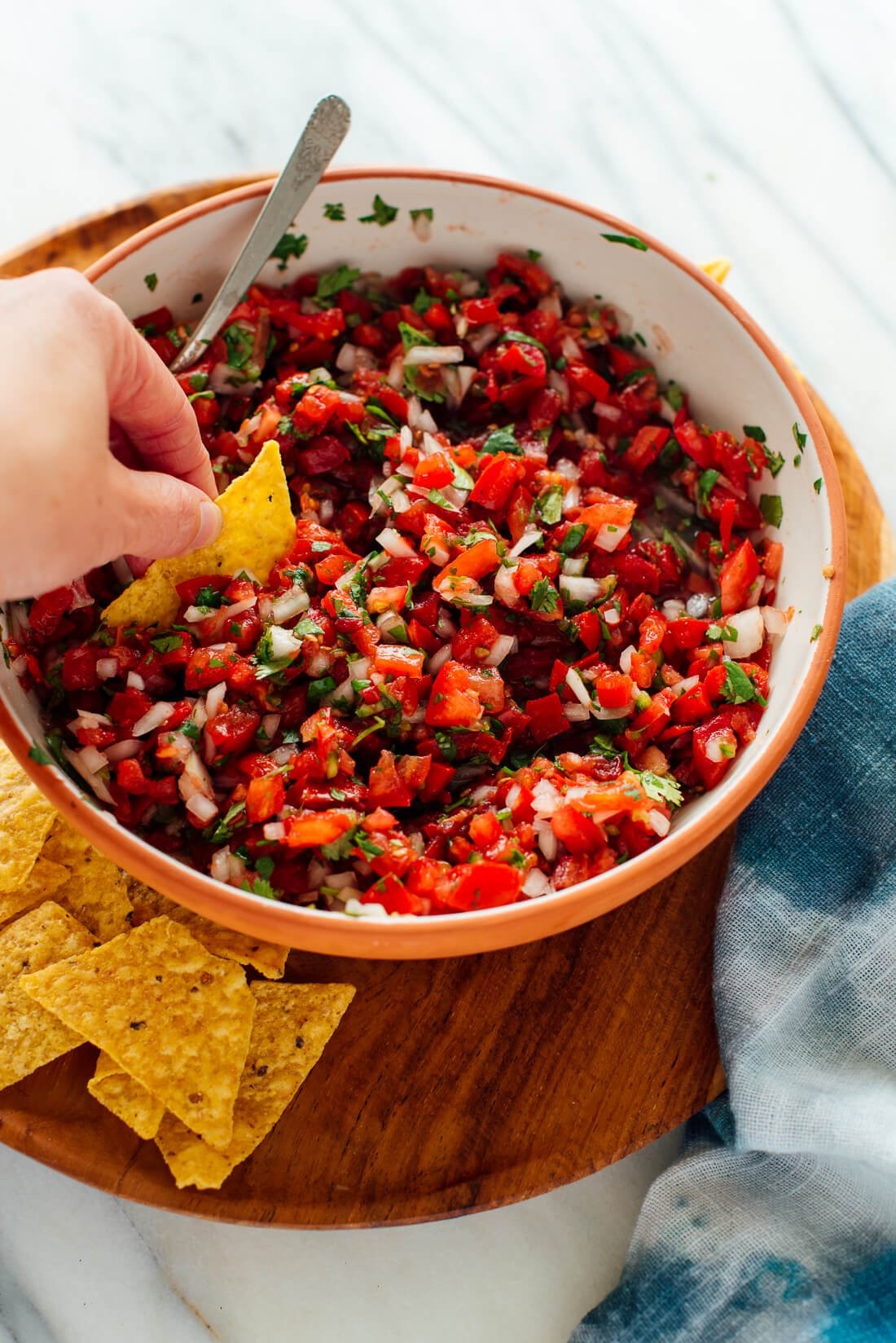Pico de gallo, that vibrant and zesty Mexican condiment, is more than just a topping. This guide on WHAT.EDU.VN explores everything about it, from its simple ingredients to its endless culinary applications. Learn how pico de gallo enhances meals and discover its cultural significance. Dive into this culinary adventure and explore the fresh flavors of homemade salsa fresca.
1. What is Pico de Gallo? Unveiling the Essence of Fresh Mexican Salsa
Pico de gallo, often dubbed “salsa fresca” or fresh salsa, is a cornerstone of Mexican cuisine, known for its bright, clean flavors and simple preparation. Unlike other cooked or processed salsas, pico de gallo relies on the freshness of its raw ingredients to deliver a satisfying crunch and a burst of taste in every bite. The essence of pico de gallo lies in its simplicity, making it a versatile and healthy addition to countless dishes. Pico de gallo boasts a vibrant mix of ripe tomatoes, sharp onions, spicy jalapeños, fresh cilantro, and tangy lime juice, creating a symphony of flavors. It is often served as a condiment, a dip, or even a light salad, enhancing the overall dining experience with its refreshing profile. This makes it an essential element in Mexican cuisine.
2. The Quintessential Pico de Gallo Ingredients: A Symphony of Freshness
The beauty of pico de gallo lies in its simplicity and the freshness of its ingredients. Each component plays a crucial role in creating the perfect balance of flavors and textures. Let’s delve into the essential ingredients that make up this classic Mexican salsa:
- Tomatoes: Ripe, red tomatoes are the heart of pico de gallo. Roma tomatoes are often favored due to their firm texture and lower water content, preventing the salsa from becoming too soggy. However, any variety of ripe tomato can be used, depending on availability and personal preference. The tomatoes provide the base sweetness and juiciness, essential for the overall flavor profile.
- Onion: White onion is traditionally used in pico de gallo for its sharp, pungent flavor that adds a delightful bite. Finely chopping the onion ensures that its flavor is evenly distributed throughout the salsa. Some variations may call for red onion, which offers a milder, slightly sweeter taste.
- Jalapeño: This spicy pepper brings the heat to pico de gallo. The amount of jalapeño used can be adjusted according to your spice preference. Removing the seeds and membranes can help reduce the heat, while leaving them in will intensify it. The jalapeño’s fiery kick balances the sweetness of the tomatoes and the sharpness of the onion.
- Cilantro: Fresh cilantro is a quintessential herb that lends a bright, citrusy aroma and flavor to pico de gallo. It complements the other ingredients, adding a layer of complexity and freshness. For those who are not fans of cilantro, a small amount of parsley can be used as a substitute, though it will alter the overall flavor profile.
- Lime Juice: The acidity of fresh lime juice is crucial for balancing the flavors and preserving the freshness of the pico de gallo. It brightens the flavors of the tomatoes, onions, and jalapeños, creating a harmonious blend. Lime juice also acts as a natural preservative, helping to keep the salsa fresh for a longer period.
- Salt: Salt is a key ingredient for enhancing the flavors of all the other components. It brings out the natural sweetness of the tomatoes, the sharpness of the onion, and the heat of the jalapeño. A pinch of salt is usually sufficient, but taste and adjust as needed to achieve the perfect balance.
3. Pico de Gallo vs. Salsa: Dissecting the Key Distinctions
While both pico de gallo and salsa are integral parts of Mexican cuisine, they are distinct in their preparation, texture, and flavor profiles. Understanding these differences will allow you to appreciate each condiment for its unique qualities.
| Feature | Pico de Gallo | Salsa |
|---|---|---|
| Ingredients | Raw, diced tomatoes, onions, jalapeños, cilantro, lime | Can include cooked or raw ingredients, various vegetables and spices |
| Texture | Chunky, fresh, and relatively dry | Can be smooth, chunky, or puréed, often more liquid |
| Preparation | Simple chopping and mixing, no cooking required | May involve roasting, cooking, or blending ingredients |
| Flavor Profile | Bright, fresh, and clean | Can range from mild to very spicy, depending on the ingredients and preparation |



Pico de gallo is characterized by its fresh, raw ingredients that are finely diced and mixed together. It has a chunky texture and a relatively dry consistency, as the ingredients are not cooked or blended. The flavor is bright, clean, and refreshing, highlighting the natural tastes of the tomatoes, onions, and cilantro.
Salsa, on the other hand, is a broader term that encompasses a wide variety of sauces, both cooked and raw. It can include a diverse range of ingredients, such as tomatoes, peppers, onions, garlic, spices, and even fruits. Salsa can be smooth, chunky, or puréed, and its consistency is often more liquid than pico de gallo. The flavor profile of salsa can vary greatly depending on the ingredients and preparation methods used.
4. Decoding “Pico de Gallo”: The Intriguing Etymology Behind the Name
The literal translation of “pico de gallo” is “rooster’s beak” in Spanish, which has led to various theories about the origin of the name. While the exact reason remains somewhat mysterious, here are a few plausible explanations:
- Chopping Motion: One theory suggests that the name refers to the way people traditionally ate pico de gallo. In the past, it was common to pinch or “peck” at the salsa with the thumb and forefinger, mimicking the way a rooster pecks at food.
- Pepper Shape: Another explanation links the name to the shape of the peppers used in the salsa. Some believe that the serrano peppers, which were historically more common in pico de gallo than jalapeños, resembled the beak of a rooster.
- Early Ingredients: It is also speculated that the original version of pico de gallo may have included ingredients that resembled bird feed, such as small seeds or grains.
- Bird-Like Consumption: Another theory suggests that the name originated from the way people consumed pico de gallo in earlier times. They would often eat it by pinching small amounts between their fingers, similar to how a bird pecks at its food. This method of consumption might have led to the association with a rooster’s beak.
Despite the uncertainty surrounding its etymology, the name “pico de gallo” has become synonymous with this beloved Mexican salsa, adding a touch of intrigue to its already vibrant character.
5. Crafting the Perfect Pico de Gallo: A Step-by-Step Guide
Making pico de gallo at home is incredibly easy, requiring just a few simple steps and fresh ingredients. Here’s a detailed guide to help you create the perfect batch:
-
Gather Your Ingredients:
- 1 1/2 pounds ripe red tomatoes, diced
- 1 cup finely chopped white onion
- 1-2 jalapeño peppers, seeded and finely chopped (adjust to your spice preference)
- 1/2 cup chopped fresh cilantro
- 1/4 cup fresh lime juice
- 3/4 teaspoon salt, or to taste
-
Prepare the Onion and Jalapeño: In a medium-sized bowl, combine the chopped white onion and jalapeño peppers. Add the lime juice and salt, and let it marinate for about 5-10 minutes. This step helps to mellow the sharpness of the onion and infuse it with the flavors of the lime and jalapeño.
-
Add the Tomatoes and Cilantro: Add the diced tomatoes and chopped cilantro to the bowl with the onion mixture. Gently stir everything together until well combined.
-
Adjust Seasoning: Taste the pico de gallo and adjust the seasoning as needed. You may want to add more salt, lime juice, or jalapeño to suit your preferences.
-
Let it Rest: For the best flavor, allow the pico de gallo to rest for at least 15-20 minutes before serving. This allows the flavors to meld together and intensify.
-
Serve and Enjoy: Serve your fresh pico de gallo with tortilla chips, tacos, grilled meats, or any other dish that could use a burst of fresh flavor.
6. Culinary Versatility: Exploring the Many Uses of Pico de Gallo
Pico de gallo’s versatility makes it a welcome addition to a wide array of dishes. Its fresh, vibrant flavors can elevate everything from simple snacks to elaborate meals. Here are just a few ideas to inspire you:
- Taco Topping: Pico de gallo is a classic topping for tacos, adding a burst of freshness and flavor to both meat and vegetarian fillings.
- Nachos: Sprinkle pico de gallo over nachos for a zesty and colorful topping that complements the cheesy, savory flavors.
- Grilled Meats: Serve pico de gallo alongside grilled chicken, steak, or fish for a refreshing contrast to the smoky flavors.
- Eggs: Top scrambled eggs, omelets, or breakfast burritos with pico de gallo for a flavorful and healthy start to the day.
- Salads: Add pico de gallo to salads for a boost of flavor and texture. It pairs particularly well with Mexican-inspired salads.
- Avocado Toast: Elevate your avocado toast with a generous spoonful of pico de gallo for a savory and satisfying snack.
- Soups: Garnish soups, such as tortilla soup or black bean soup, with pico de gallo for a fresh and vibrant finish.
- Dips: Serve pico de gallo as a dip with tortilla chips or vegetable sticks for a healthy and flavorful appetizer.
7. Health Benefits of Pico de Gallo: A Nutritious Condiment
Beyond its delicious taste, pico de gallo offers several health benefits thanks to its fresh, natural ingredients. Here are some of the key nutritional advantages:
- Rich in Vitamins: Tomatoes are an excellent source of vitamin C and vitamin A, both of which are important for immune function and overall health.
- Antioxidants: The ingredients in pico de gallo, particularly tomatoes and cilantro, are rich in antioxidants, which help protect the body against cell damage.
- Low in Calories: Pico de gallo is a low-calorie condiment, making it a healthy way to add flavor to your meals without adding extra calories.
- Hydrating: The high water content of tomatoes and lime juice can help keep you hydrated.
- Fiber: Tomatoes and onions provide a good source of dietary fiber, which aids in digestion and promotes gut health.
- Anti-Inflammatory Properties: Jalapeños contain capsaicin, a compound known for its anti-inflammatory properties.
8. Tips and Tricks for the Best Pico de Gallo: Elevate Your Salsa Game
To ensure that your pico de gallo is always a hit, here are some helpful tips and tricks to keep in mind:
- Use the Freshest Ingredients: The key to great pico de gallo is using the freshest, highest-quality ingredients possible. Choose ripe, red tomatoes, crisp onions, and vibrant cilantro.
- Finely Dice the Ingredients: Finely dicing the ingredients ensures that the flavors are evenly distributed and that the salsa has a consistent texture.
- Marinate the Onion: Marinating the chopped onion in lime juice and salt helps to mellow its sharpness and infuse it with flavor.
- Remove Seeds from Jalapeños: If you prefer a milder pico de gallo, remove the seeds and membranes from the jalapeños before chopping them.
- Don’t Overmix: Gently stir the ingredients together to avoid bruising the tomatoes and making the salsa watery.
- Let it Rest: Allowing the pico de gallo to rest for at least 15-20 minutes before serving allows the flavors to meld together and intensify.
- Serve with a Slotted Spoon: To avoid serving excess liquid, use a slotted spoon to transfer the pico de gallo to plates or bowls.
- Make it Ahead: Pico de gallo can be made a few hours ahead of time and stored in the refrigerator. However, it is best served fresh for the best flavor and texture.
9. Pico de Gallo Variations: A World of Flavor Possibilities
While the classic pico de gallo recipe is delicious on its own, there are countless variations you can try to customize the flavors to your liking. Here are a few ideas to get you started:
- Mango Pico de Gallo: Add diced mango for a sweet and tangy twist. The sweetness of the mango pairs beautifully with the spicy jalapeño and the acidity of the lime juice.
- Pineapple Pico de Gallo: Substitute some of the tomatoes with diced pineapple for a tropical flavor. The pineapple adds a juicy sweetness and a hint of acidity.
- Avocado Pico de Gallo: Add diced avocado for a creamy and rich texture. The avocado complements the other ingredients and adds a healthy dose of fats.
- Corn and Black Bean Pico de Gallo: Add cooked corn kernels and black beans for a heartier and more filling salsa. This variation is great as a dip or as a topping for grilled meats.
- Strawberry Pico de Gallo: Replace some of the tomatoes with diced strawberries for a sweet and slightly tart flavor. This variation is perfect for summer gatherings.
- Peach Pico de Gallo: Use diced peaches instead of tomatoes for a summery, sweet, and juicy variation.
10. Storing Pico de Gallo: Maintaining Freshness and Flavor
Proper storage is essential to maintain the freshness and flavor of your homemade pico de gallo. Here are some guidelines to follow:
- Refrigerate Promptly: Store pico de gallo in an airtight container in the refrigerator as soon as possible after making it.
- Use an Airtight Container: An airtight container will help prevent the pico de gallo from drying out and absorbing odors from the refrigerator.
- Consume Within a Few Days: Pico de gallo is best consumed within 2-3 days of making it. After that, the tomatoes may start to break down, and the flavors may become less vibrant.
- Drain Excess Liquid: If the pico de gallo becomes watery, drain off any excess liquid before serving.
- Avoid Freezing: Freezing pico de gallo is not recommended, as it will alter the texture of the tomatoes and make the salsa mushy.
11. Troubleshooting Common Pico de Gallo Problems: Solutions for Salsa Success
Even with the simplest recipes, things can sometimes go awry. Here are some common problems you might encounter when making pico de gallo, along with solutions to help you achieve salsa success:
- Too Watery:
- Problem: The pico de gallo is too watery, making it less appealing.
- Solution: Use Roma tomatoes, which have less water content. Remove the seeds from the tomatoes before dicing them. Drain off any excess liquid before serving.
- Too Spicy:
- Problem: The pico de gallo is too spicy for your taste.
- Solution: Use fewer jalapeños, or remove the seeds and membranes before chopping them. Add a touch of sugar or honey to balance the heat.
- Not Enough Flavor:
- Problem: The pico de gallo lacks flavor and tastes bland.
- Solution: Add more salt, lime juice, or cilantro. Let the pico de gallo rest for a longer period to allow the flavors to meld together.
- Onions Too Strong:
- Problem: The onions are too strong and overpowering.
- Solution: Soak the chopped onions in cold water for 10-15 minutes before adding them to the salsa. Marinate the onions in lime juice and salt to mellow their sharpness.
12. The Cultural Significance of Pico de Gallo in Mexican Cuisine
Pico de gallo is more than just a condiment; it’s a symbol of Mexican culinary heritage. Its fresh, vibrant flavors and simple preparation reflect the country’s emphasis on using local, seasonal ingredients. Pico de gallo is a staple at family gatherings, fiestas, and celebrations, where it is enjoyed as a shared dish that brings people together.
The preparation of pico de gallo is often a communal activity, with family members gathering to chop vegetables and share stories. This tradition reinforces the importance of food as a means of connection and cultural identity. Pico de gallo is also a versatile dish that can be adapted to suit regional preferences and available ingredients, showcasing the creativity and resourcefulness of Mexican cooks.
13. Frequently Asked Questions About Pico de Gallo
Here are some frequently asked questions about pico de gallo:
| Question | Answer |
|---|---|
| Can I use other types of tomatoes? | Yes, while Roma tomatoes are preferred for their lower water content, you can use any ripe tomato variety. |
| How long does pico de gallo last in the fridge? | Pico de gallo is best consumed within 2-3 days for optimal freshness. |
| Can I make pico de gallo ahead of time? | Yes, you can make it a few hours in advance, but it’s best served fresh. |
| What can I substitute for cilantro? | If you don’t like cilantro, you can use parsley, though it will alter the flavor. |
| How do I make pico de gallo less spicy? | Remove the seeds and membranes from the jalapeños, or use a milder pepper. |
| Can I freeze pico de gallo? | Freezing is not recommended as it changes the texture of the tomatoes. |
| What’s the difference between pico and salsa roja? | Pico de gallo is made with fresh, raw ingredients and has a chunky texture, while salsa roja is often cooked and can be smooth or chunky. |
| Can I add other vegetables to pico de gallo? | Yes, you can add vegetables like cucumber, bell peppers, or corn to customize your pico de gallo. |
| Is pico de gallo healthy? | Yes, it’s low in calories and rich in vitamins, antioxidants, and fiber. |
| How do I prevent my pico from getting watery? | Use Roma tomatoes, remove the seeds, and drain any excess liquid before serving. |
14. The Final Verdict: Why Pico de Gallo is a Culinary Essential
Pico de gallo is a culinary essential for its simplicity, versatility, and health benefits. Its fresh, vibrant flavors can elevate any dish, making it a staple in Mexican cuisine and a favorite among food lovers worldwide. Whether you’re topping tacos, grilling meats, or simply enjoying it with tortilla chips, pico de gallo is sure to add a burst of flavor and freshness to your meal.
15. Beyond the Recipe: Exploring the Endless Possibilities of Fresh Salsa
Now that you’ve mastered the art of making classic pico de gallo, it’s time to explore the endless possibilities of fresh salsa. Experiment with different ingredients, flavors, and textures to create your own signature salsa that reflects your personal taste and culinary preferences. Here are a few ideas to inspire you:
- Fruit Salsas: Combine sweet fruits like mango, pineapple, or strawberries with savory ingredients like onions, jalapeños, and cilantro for a unique and refreshing salsa.
- Vegetable Salsas: Use a variety of colorful vegetables like bell peppers, cucumbers, and corn to create a vibrant and healthy salsa.
- Spicy Salsas: Add different types of chili peppers, such as habaneros or serranos, to kick up the heat in your salsa.
- Herbaceous Salsas: Experiment with different herbs like mint, basil, or oregano to add a fresh and aromatic twist to your salsa.
- Nutty Salsas: Incorporate toasted nuts like pecans, walnuts, or almonds for added texture and flavor.
The possibilities are endless, so let your creativity guide you and have fun exploring the world of fresh salsa!
16. Where to Learn More: Expanding Your Culinary Knowledge on WHAT.EDU.VN
Do you have more burning questions about food, cooking, or anything else under the sun? Don’t hesitate! At WHAT.EDU.VN, we’re dedicated to providing you with fast, free answers to all your queries. Our community of experts is ready to tackle any topic, big or small.
Struggling to understand a complex concept? Need help with a homework assignment? Curious about a random fact? Just ask! WHAT.EDU.VN is your go-to resource for reliable information and helpful explanations.
Here’s how to get started:
- Visit our website: WHAT.EDU.VN
- Type your question into the search bar.
- Browse our extensive library of answered questions.
- If you can’t find what you’re looking for, simply submit your own question.
Our team of experts will provide you with a detailed, easy-to-understand answer as quickly as possible.
17. Call to Action: Ask Your Questions and Get Free Answers on WHAT.EDU.VN
Still have questions about pico de gallo or any other topic? Don’t hesitate to ask! WHAT.EDU.VN offers a free platform where you can get answers to all your burning questions. Whether you’re curious about cooking techniques, historical facts, or scientific concepts, our community of experts is here to help.
Why spend hours searching the internet when you can get reliable answers in minutes? Visit WHAT.EDU.VN today and start exploring the world of knowledge!
Ready to get started?
- Go to WHAT.EDU.VN
- Submit your question.
- Get your answer for free!
Join the WHAT.EDU.VN community and unlock a world of knowledge at your fingertips.
For any inquiries, feel free to contact us:
Address: 888 Question City Plaza, Seattle, WA 98101, United States
WhatsApp: +1 (206) 555-7890
Website: what.edu.vn
We’re here to help you learn and grow!

